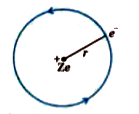Using Bohr's atomic model, derive an equation of the radius of the nth orbit of an electron. Solution in Gujrati
The atomic model of Bohr is shown in the figure.

Let mass of an electron m, charge e, linear speed in nth orbitvn and orbit with radius rn and charge on nucleus Ze, where Ze = atomic number of an element.
The necessary centripetal force is provided Colombian attractive force between electron and nucleus. Thus.
∴mv2nrn=14πε0⋅(Ze)(e)r2n=ze24πε0r2n
where ε0= permittivity of medium
From Bohr hypothesis 2, if the anguli momentum of electron in nth orbit is Lnm
Ln=(nh)
∴mvnrn=nhπ ...(2)
From equation (1),
vn(mvnrn)=Ze24πε0
Putting the vlaue of equation (2),
vn−(nh)(2π)−Ze24πε0 [ From equation (2)]
∴vn=Ze24πε0⋅1nh2π
∴vn=1n⋅Ze22hε0 ...(3)
∴vn∝Zn where e,2h,ε0 constant
Hence orbital velocity in nth orbit velocity decreases by a factor of n.
For hydrogen atom Z = 1,
vn∝1n
Now from equation (2).
rn=nh2πmvn
Putting the value of eqution (3).
rn=nh×n×2hε02πm×Ze2
∴rn=n2h2ε0πmZe2
∴rn∝n2Z[∴ all other terms are contant]
For hydrogen Z=1
∴rn=n2h2ε0πme2 ...(4)
∴rn∝n2 [ ∴ All other terms are constant] The size of the innermost orbit (n = 1) is called Bohr radius, represented by the symbol a0 thus Putting n = 1 in equation (4),
r1=a0=n2(h2ε0πme2)
putting the values of hε0,π and.
a0=5.29×10−11m or approximately 0.53Å
Topper's Solved these Questions
- BOOK - KUMAR PRAKASHANCHAPTER - ATOMSEXERCISE - TRY YOURSELF43videos
ATOMS
- BOOK - KUMAR PRAKASHANCHAPTER - ATOMSEXERCISE - SECTION-B (NUMERICALS) (Numerical From Textual Illustrations)9videos
ATOMS
- BOOK - KUMAR PRAKASHANCHAPTER - ALTERNATING CURRENTS EXERCISE - SECTION-D MCQs (COMPETITIVE EXAMS)64videos
ALTERNATING CURRENTS
- BOOK - KUMAR PRAKASHANCHAPTER - BOARD'S QUESTION PAPER MARCH-2020 EXERCISE - PART-B SECTION -C4videos
BOARD'S QUESTION PAPER MARCH-2020
Similar Questions
Why atoms are electrical neutral ?
01:43View SolutionIn the Rutherford’s nuclear model of the atom, the nucleus (radius about 10–15 m) is analogous to the sun about which the electron move in orbit (radius ≈10–10 m) like the earth orbits around the sun. If the dimensions of the solar system had the same proportions as those of the atom, would the earth be closer to or farther away from the sun than actually it is? The radius of earth’s orbit is about 1.5×1011m. The radius of sun is taken as 7×108m.
02:05View SolutionPower factor of AC series circuit having resistance R and inductor L having angular frequency ω is ……..
06:10View SolutionDerive an expression for current I passing through an AC circuit containing only inductor L. Draw a Phasor diagram and graph of v and I versus ωt. Explain instantaneous power and the average power.
03:27View SolutionAccording to Bohr's theory of hydrogen atom , the product of the binding energy of the electron in the nth orbit and its radius in the nth orbit
01:24:23View SolutionUsing Bohr's postulate, derive the expression for the orbital period of the electron moving in the nth orbit of hydrogen atom.
01:24:23View Solutionबोहर के परमाणविक मॉडल के अभीगृहितों का उल्लेख कीजिए। इसके आधार पर इलेक्ट्रॉन की n वीं कक्षा की त्रिज्या के लिए व्यंजक प्राप्त कीजिए।
View SolutionUsing Bohr's postulates of the atomic model, derive the expression for radius of n-th electron orbit. Hence obtain the expression for Bohr's radius.
05:49View SolutionAtomic spectra of hydrogen | Bohr's model of atom | Bohr's postulates | Derivation of radius and velocity of Bohr's orbit
View SolutionAtomic spectra of hydrogen | Bohr's model of atom | Bohr's postulates | Derivation of radius and velocity of Bohr's orbit
View SolutionUsing Bohr's atomic model, derive the expression for the radius of nth orbit of the revolviting electron in a hydrogen atom.
View SolutionDerive an expression for the radius of nth Bohr's orbit of hydrogen atom hence write the expression for the radius of first orbit of hydrogen atom.
06:29View SolutionConsider an electron in the nth orbit of a hydrogen atom in the Bohr's model. In terms of de-Broglie wavelength of that electron the circumference of the orbit is given as .
02:15View SolutionUsing Bohr's postulates of the atomic model, derive the expression for radius of th electron orbit. Thus, obtain the expression of Bohr's radius.
57:02View SolutionDerive the expression for the radius of nth Bohr's orbit in Hydrogen atom.
06:10View Solution

